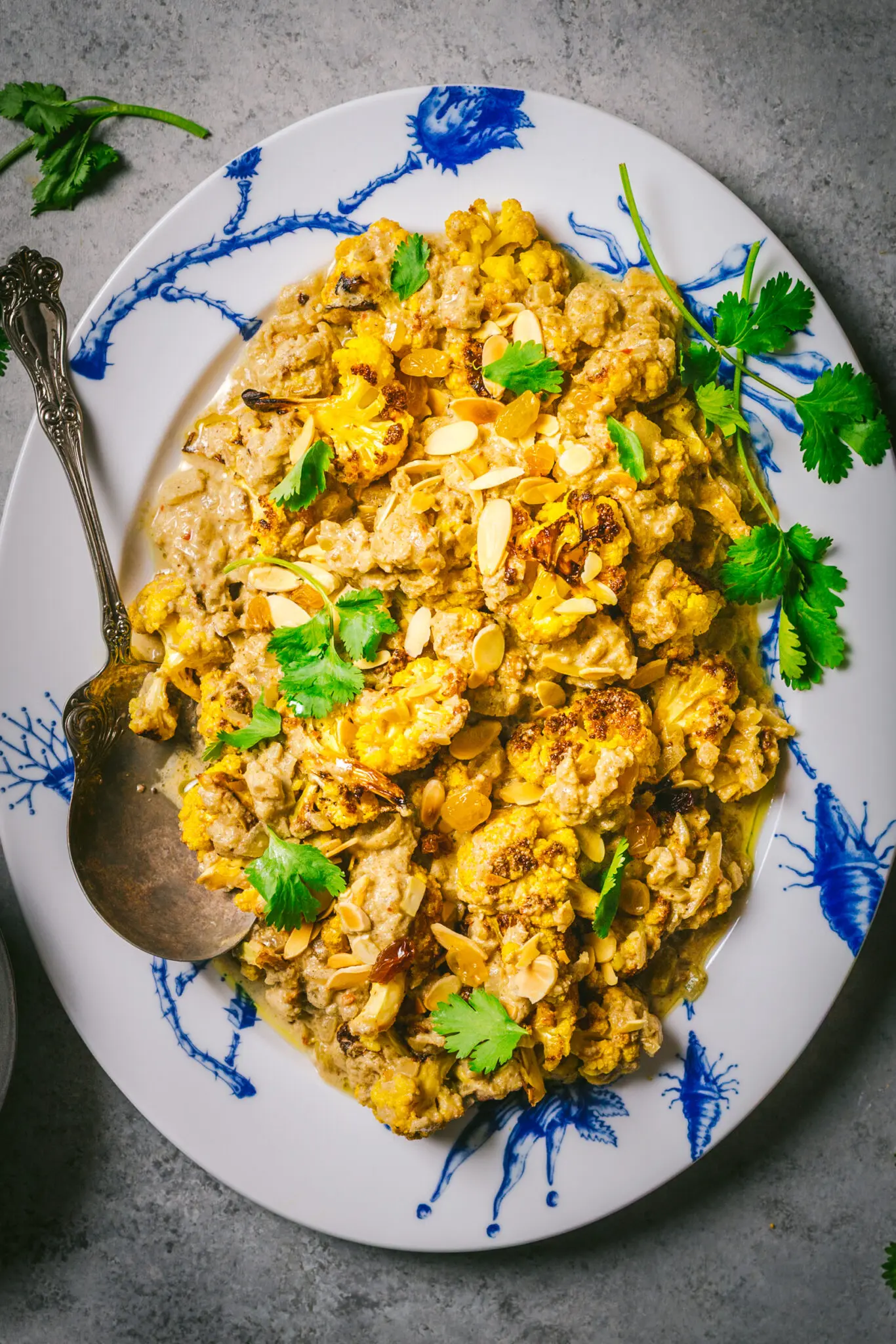
When your childhood introduction to most vegetables is through their boiled varieties, you might be forgiven for seeking any alternative — anything at all! — to another plate of pallid, soggy specimens. I’m not saying rural England in the 1970s was unimaginative when it came to mealtimes, but … well, yes, that is actually what I’m saying. I am saying exactly that. Nothing was immune to the standard preparation (boiled beyond all recognition). I couldn’t again face parsnips or rutabaga (what we called “swede” which was served up in tiny cubes from a can) until well into my 30s. And then, of course, there was the poor old cauliflower. It’s such a healthy food – packed with nutrients and vitamins, but if you’re just going to boil it to death, what’s the point?
This article is part of our collaboration with Serious Eats.
The Heart of the Dish: Cauliflower
The first time I had cauliflower roasted, I felt like my eyes had been opened. This unassuming vegetable which had never made it past “side dish” status could be transformed into something with texture, color and sweet, caramel notes. I started noticing cauliflower steaks and soups popping up on restaurant menus.
I’ve even tried to grow it, but without too much success. It may be versatile in the kitchen, but it’s fussy in the garden. Like most brassicas (cruciferous vegetables) it doesn’t like excess heat, and the surrounding leaves protect the head from the sun to create that pure white color. In the Northeast, local varieties are harvested in the cooler months of fall, and California has a strong cauliflower crop through most of the year. That means you can reliably find good varieties of cauliflower at your local store pretty much all year round.
In the last few years, you may have noticed some fancy varieties alongside the classic white. There’s an orange cultivar, known as Cheddar. The color comes from an excess of beta carotene and it contains about 25% more vitamin A than white cauliflower. The purple variety gets its color from the antioxidant anthocyanin, which is also found in red cabbage and red wine.
You can use any variety you like though we chose the orange, which we thought would be ideal to combine with that other legacy of British colonial culinary history – the curry.
About Mughlai
Mughlai is a general term for a style of cooking in India, and mughlai chicken often refers to a creamy, slow simmered sauce flavored with almonds, spices including cinnamon and garam masala, and golden raisins (or sultanas). But you don’t have to stick to meat: the combination of flavors is perfectly suited to roasted mughlai cauliflower.
Like with most curry recipes, the quality of the finished dish is directly related to the quality of the spices used in it. You’ll need quite a few, so this is a great opportunity to expand your spice cabinet, if you don’t have these already. For pre-ground spices, we like to buy small jars because they lose much of their potency after about 6 months. Whole spices are good for about a year. As always, it’s best to store the jars in a cool, dark place.
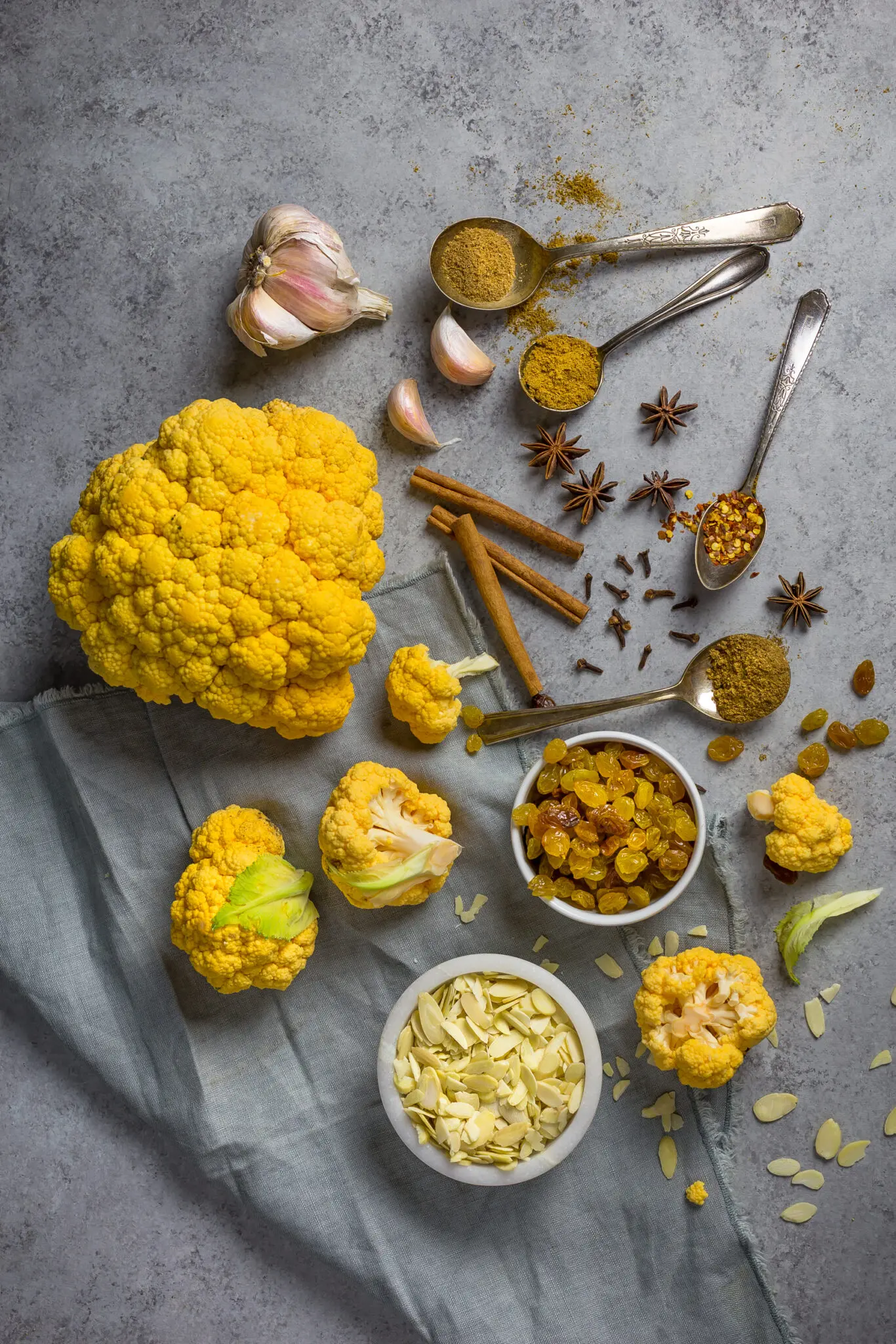
There’s one other key ingredient in this mughlai cauliflower recipe: golden raisins (you could also use sultanas). Unlike their cousins, which we will simply call “regular raisins”, these versions are dried using a process which keeps their skins light-colored. They also stay a little juicier than the regular kind. While Emily generally distrusts raisins for their bait-and-switch role in cookies (she calls them “I Can’t Believe They’re Not Chocolate Chips” and occasionally “the Devil’s freckles”), the golden variety are great in this recipe, adding a chew and a sweetness that marries well with both the light and the fiery spices.
How To Make the Curry
Let’s talk about preparing this delight for the senses. The first thing you’ll need to do is roast your cauliflower. Separate the florets into large bite-size florets, so they can be combined directly into the sauce and won’t take overly long to cook. Twenty minutes in a hot oven, turned once, should be plenty to turn it golden and tender. While it’s roasting, you can get the sauce going.
The key ingredient here is finely ground almonds. You might be able to find them already pre-ground at a health food store, but it’s easy enough to whizz up the flaked ones (not roasted and salted!) in a food processor. You’ll also want some flaked almonds to garnish at the end, so don’t forget to set some aside for that.
To start the sauce, soften the onions with the “hard” spices (cinnamon stick, star anise, cloves) and then add the powdered spices, ground almonds and a little water, and cook until the water is absorbed and the nuts and spices are toasted. This step is crucial to ensure that you don’t get a raw spice flavor, and the full complexity of the taste and aromas develop. Finally the yogurt and other ingredients get stirred in, and once it’s been simmered and thickened, you can stir in the roasted cauliflower until it’s hot and coated in the creamy sauce. Then transfer it to a serving platter and sprinkle it with toasted, flaked almonds and some fresh cilantro.
Serving
We love serving mughlai cauliflower with basmati rice and fresh home-made raita – plain yogurt with sliced or grated cucumber and roughly-chopped mint leaves – which provides a cool counterpoint to the hot main dish.
This dish made one of us love cauliflower again, and the other of us not hate raisins. We can’t fix all the problems of the world but that, I think, is a decent start.
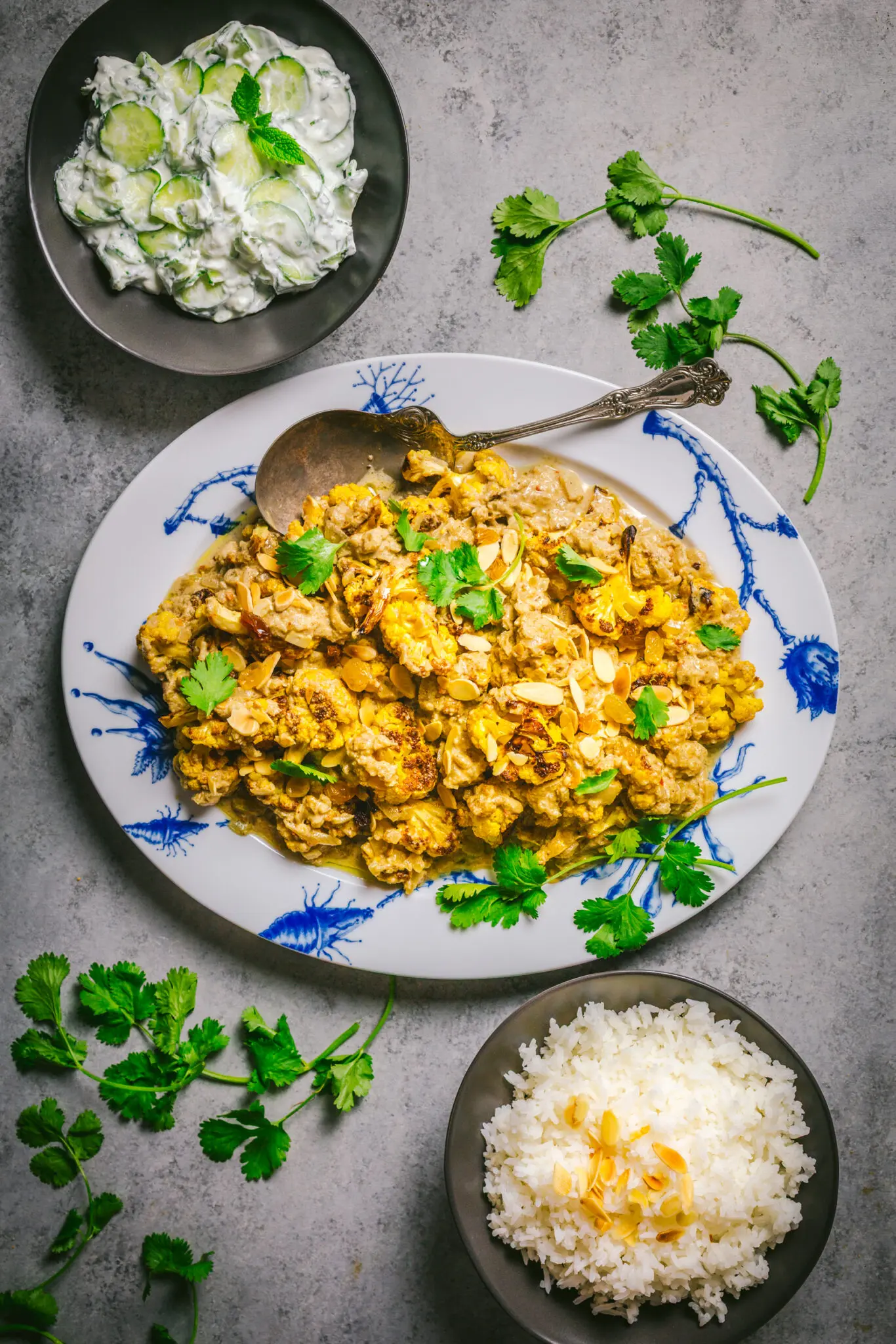
Mughlai Cauliflower
Ingredients
- 1/4 cup vegetable oil divided
- 1 large cauliflower cored and cut into large (3-inch) florets (1.5lb)
- Coarse kosher salt and cracked black pepper
- 2 medium yellow onions finely chopped (500g)
- 1 cinnamon stick broken in half
- 4 cloves
- 1 star anise pod
- 1 1-inch piece ginger, peeled and grated (30g)
- 4 garlic cloves grated or minced (25g)
- 2 teaspoons ground cumin 5g
- 2 teaspoons ground coriander 5g
- 1 teaspoon dried chili flakes 2g
- 1 tablespoon garam masala 8g
- 1/4 cup ground almonds 30g (or grind 1/3 cup of flaked almonds)
- 1/2 cup water
- 1 cup Greek yogurt
- 1 cup vegetable or chicken broth
- 1/2 cup heavy cream
- 1/2 cup golden raisins sultanas
- 1 tablespoon brown sugar
- 1 teaspoon kosher salt
- 1/4 cup flaked almonds toasted, to garnish
- Cilantro leaves and tender stems
Instructions
- Preheat oven to 425ºF and place rack in middle position. Toss cauliflower with 2 tablespoons oil, season with salt and pepper. Place on a sheet pan in a single layer and roast until golden brown on one side, about 10 minutes. Turn and roast until brown on other side and just tender, 7 to 10 minutes. Remove from oven and set aside.
- If you’re grinding your own almonds, put them in a food processor, pulse until nuts are medium to finely ground. remove to a bowl.
- Heat 2 tablespoons oil in a large straight-sided skillet set over medium-high heat and add the onions, cinnamon, cloves and star anise and cook until onions are soft and lightly browned, 5 to 7 minutes. Add the ginger, garlic, cumin, coriander, chili, garam masala, ground almonds and 1/2 cup water. Cook, stirring often until the water is absorbed and the nuts begins to brown, 5 minutes. Stir in the yogurt, stock, cream, raisins, salt and sugar. Simmer for 10-15 minutes, until sauce thickens. If it gets too thick, add a little more water or broth. Stir in roasted cauliflower and toss until cauliflower is hot and coated in sauce, 2 to 3 minutes. Transfer to a serving dish and scatter with the toasted flaked almonds and cilantro.

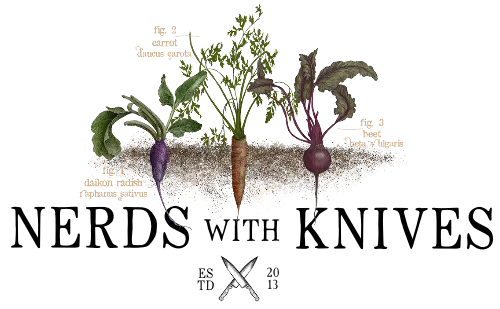
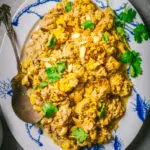
5
Made this along with a mughlai chicken, raita and basmati rice, what a great meal. Looks like it will be easy to increase this recipe to make a larger batch too so we have leftovers for lunch at work.
Wow, thanks so much for this recipe. Possibly the best curry I’ve ever eaten – truly delicious!
So, I made this yesterday and, indeed, it was delicious! However, my curry was a decidedly “different” color than the picture above. (Brown like turkey gravy.) I noticed this recipe doesn’t call for any turmeric. So, I added some to make the overall dish look a little more appetizing. Did I miss something?
I think the mughlai curries are a reference to the style of cooking created in Mughal courts a long time back. All the Mughal dishes I have seen use a lot of raisins, almonds, star anise and ghee particularly. My favorite would be the mughlai biryani. Thanks for sharing the above recipe. I’ll definitely try it out.